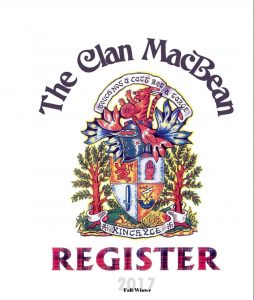contact
Contact the Clan MacBean
| Clan Office | The Clan MacBean, Inc., PO Box 260817, Lakewood, CO 80226 Phone: 303-233-6002 |
clanoffice@clanmacbean.org | |
|---|---|---|---|
| The Editor of the Register | editor@clanmacbean.org | ||
| Web concerns | rmcbain@clanmacbean.org | ||
| The Genealogist | genealogist@clanmacbean.org |
*The genealogist can only provide genealogical assistance to current members of the clan
Contact Us
[contact-form-7 id="2912" title="Contact form 1"]
Membership Benefits
– Access to our genealogical data via our Genealogist
– A subscription to our bi-annual newsletter, The Register (See a past copy)
– Member pricing on ancestor biographies
– Member pricing on Scottish goods
– News of Scottish events and Highland Games
– Periodic opportunities for group travel to Scotland
- New memberships start as low as 25.00 per year
- lifetime membership for only 16.00 per month, for 24 months, and a one time 16.00 setup fee.
- Renew you membership
- Shop
Our Organization
Clan MacBean Inc.
This organization was started as The John Bean of Exeter Family Associationbut eventually became dormant. At that time there was no recognized Chief of Clan MacBean.
Bernie Bean started Clan Macbean in North America, Inc.as a way to resurrect and expand the old association. The Organization is controlled by the membership through the Board of Directors and the elected officers.
In 1996 the website was first launched and as more people around the world got in contact we changed our name to Clan MacBean, Inc. to better reflect the nature of the organization.
With this name change we also that we also recieved a new tax status as a non-profit.
list of Officers, Directors-Executive Committees since 1896
Brief Statement of Our Tax Status
The purpose of Clan MacBean, Inc. is to educate and inform persons of contributions to Scottish history, heritage and culture made by members of the ancient Clan MacBean of Scotland,
the ancient Clan Chattan Confederation of Scotland (of which Clan MacBean is a constituent) and descendants of both through a variety of educational activities including but not limited to the dissemination of histories, genealogies,
works of art and other appropriate undertakings.
To foster these activities, the IRS has granted Clan MacBean, Inc. status as a 501(c)(3) charitable educational organization.
This means that contributions to our organization are tax deductible and may be claimed as charitable deductions on the contributor’s federal income tax.
The Register
 Members of the Clan MacBean receive access to our bi-annual electronic newsletter The Clan MacBean Register. In it you will find articles about people in the clan, historical figures, and Scottish history, along with Genealogical queries and updates of births, marriages, and deaths and news of upcoming events such as our Clan Gatherings and Festivals. We are always looking for new ideas and information to add, so if you have something you’d like to contribute, please contact our editor.
Members of the Clan MacBean receive access to our bi-annual electronic newsletter The Clan MacBean Register. In it you will find articles about people in the clan, historical figures, and Scottish history, along with Genealogical queries and updates of births, marriages, and deaths and news of upcoming events such as our Clan Gatherings and Festivals. We are always looking for new ideas and information to add, so if you have something you’d like to contribute, please contact our editor.
Please feel free to peruse a recent Register to get an idea of what these newsletters are like.
Clan MacBean Library
This is your access point to our Ancestor Photo Galleries with over 3000 ready-to-download old photos, our Lineage Document File, and our History and Genealogy Trees.
The complete first Volume of Bernie Bean’s Clan MacBean in North America is here in tree form, as well as updated lineages from Volumes II, and III with additional new research.
While you’re here check out the Register Archive of all of our old Clan newsletters, complete with stories and photos, and use the links to our current Y-DNA Project Pages.
Also in the Members’ Section, you will find the History of our Clan, and be able to meet our American Scottish Chief.
All this is online in the Member Section. Not a Member? join now!
Tartan
Family tartans have a fairly recent history (if over 200 years is recent). Historical evidence of tartan material goes back to 1600 and before, but there seems to be no evidence that any particular design or pattern could be associated with a clan. There is some evidence that in the early 1700’s some patterns became associated with the Chief, and use of that design was limited to the Chief and his family. The only remaining use of this custom is the British Royal family Tartan which is designated exclusively for the Royal family and cannot be used by others in the UK. After the failed attempt to regain the British throne by Charles Edward Stuart, the government moved to outlaw “things associated with the recent rebellion” including bagpipes (except in government controlled military units), all manner of weapons, and tartan worn by men. This ban was lifted in early 1800’s and Scots rushed to proclaim their Scottish heritage by wearing the now legal tartan. Books were published showing which tartan went with what name, and where none was known to exist, the tartan weaving business was happy to create a pattern for your family.
The MacBean tartan appeared at this time and it was in some ways similar to the Mackintosh tartan. It was considered quite bold and striking as befitting a “warlike Clan. The earliest recorded sighting of MacBean tartan was by the author Mclan 1847.The earliest fabrics were treated with vegetable dyes in many cases and the colors were softer than that which are seen with modern chemical dyes. These colors are still offered today (made now by chemical dyes) to resemble the older tartans. These are now designated as our Ancient tartan.
The next design to appear was a result of these new dyes and is currently the most recognizable style of McBain/MacBean tartan. It is known as the standard or modern tartan. It’s appearance varies from weaver to weaver as each mill independently interprets the colors. I have in my Files six examples of early MacBain tartans and they are quite different from each other. Variations are the Coulson Bonner, the Johnston, the Mclan, the Dalgleish, the MacGregor-Hastie and the Highland society of London. The tartan offered today conforms to the acceptable standard of MacBean/McBain. The McBain dress tartan was created by Jamie Scarlett at the request of McBain highland dancers who require a whiter design
to show their performance in the best light. Also, many members of the Clan wished to own a “dressier design”. It is simply a modern tartan with most of the red removed and the addition of a Mackintosh stripe, making it a most unique dress tartan. McBain hunting tartan is the most recent designation. When members of the Clan approached me asking for a hunting McBain, my first response was that I did not want to have too many different tartans in our Clan. Stewart for example has over 20 different ones. So the suggestion came, “why not use the muted tartan as a hunting tartan?”, and I felt it would be perfect. The muted or reproduction tartan came from the thought that, when wearing the tartan was banned, some people buried their tartan material in the ground for a future time when they could use it again. Well, if tartan or any material is buried in the soil of Scotland it would be stained a darker tone because of the peat in the soil. Therefore when the tartan could be worn again, it was dug up and used with the brown stain, the cause of the “muted” tartan. Somewhere along the line it also became known as a “reproduction” tartan. This then is the source of the hunting tartan. Darker shades made it more suitable for hunting or any activity where the bright colors could be a disadvantage. These are the stories of the McBain/MacBean tartans.
Members Login
Alan Bean
Enter content here. Lorem ipsum dolor sit amet, consectetur adipiscing elit. Ut elit tellus, luctus nec ullamcorper mattis, pulvinar dapibus leo. Lorem ipsum dolor sit amet, consectetur adipiscing elit. Ut elit tellus, luctus nec ullamcorper mattis, pulvinar dapibus leo.

Alan Bean
Enter content here. Lorem ipsum dolor sit amet, consectetur adipiscing elit. Ut elit tellus, luctus nec ullamcorper mattis, pulvinar dapibus leo. Lorem ipsum dolor sit amet, consectetur adipiscing elit. Ut elit tellus, luctus nec ullamcorper mattis, pulvinar dapibus leo.

Alan Bean
Enter content here. Lorem ipsum dolor sit amet, consectetur adipiscing elit. Ut elit tellus, luctus nec ullamcorper mattis, pulvinar dapibus leo. Lorem ipsum dolor sit amet, consectetur adipiscing elit. Ut elit tellus, luctus nec ullamcorper mattis, pulvinar dapibus leo.

Alan Bean
Enter content here. Lorem ipsum dolor sit amet, consectetur adipiscing elit. Ut elit tellus, luctus nec ullamcorper mattis, pulvinar dapibus leo. Lorem ipsum dolor sit amet, consectetur adipiscing elit. Ut elit tellus, luctus nec ullamcorper mattis, pulvinar dapibus leo.
